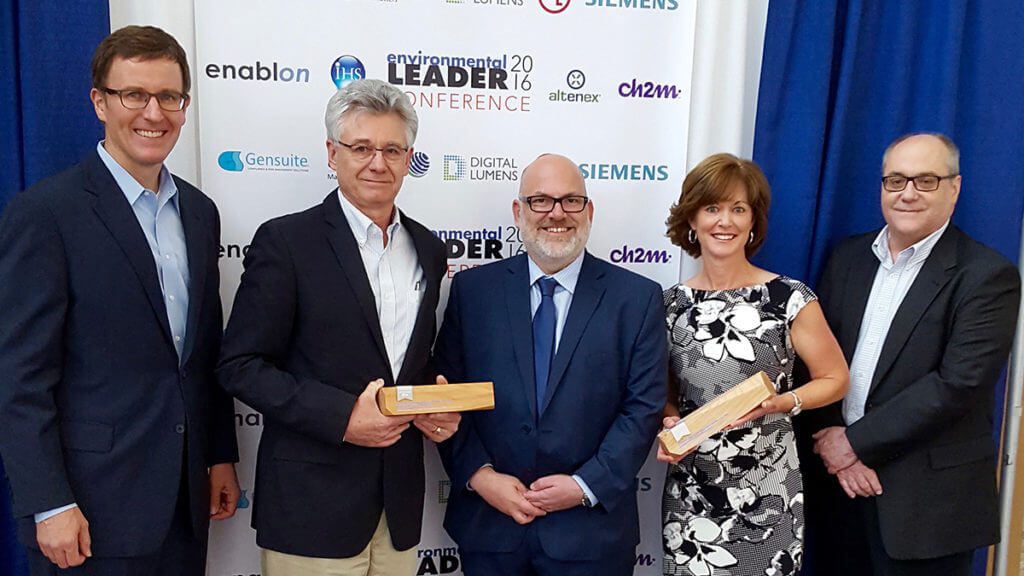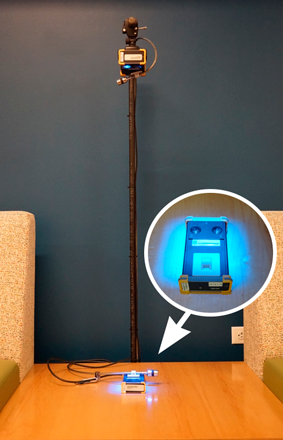Consumer
CES 2018: Cable’s Impact
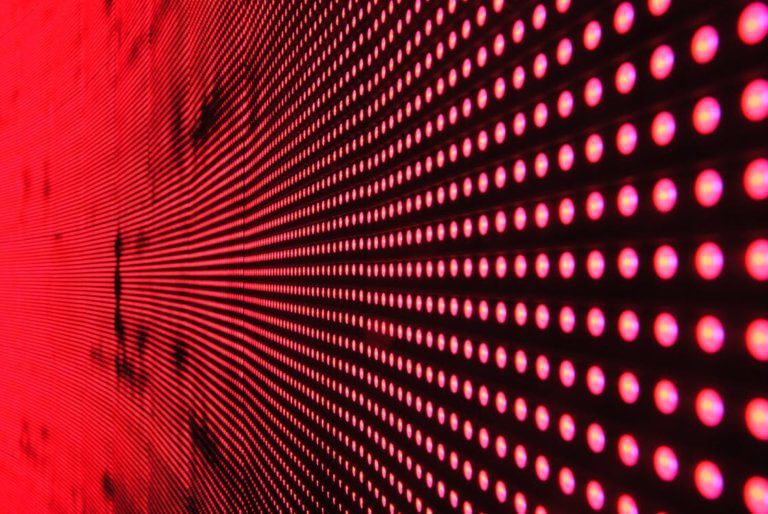
Today marked the beginning of the 2018 Consumer Electronics Show (CES) in Las Vegas, Nevada. Owned and produced by the Consumer Technology Association (CTA), with over 170,000 attendees from 150 countries and more than 3,900 exhibiting companies, CES is one of the world’s largest tech trade shows and serves as the global stage for next-generation innovations. Showcasing jaw-dropping technology in areas like VR and smart homes, most of the products or marketplaces at CES 2018 are serviced or impacted by the cable industry:
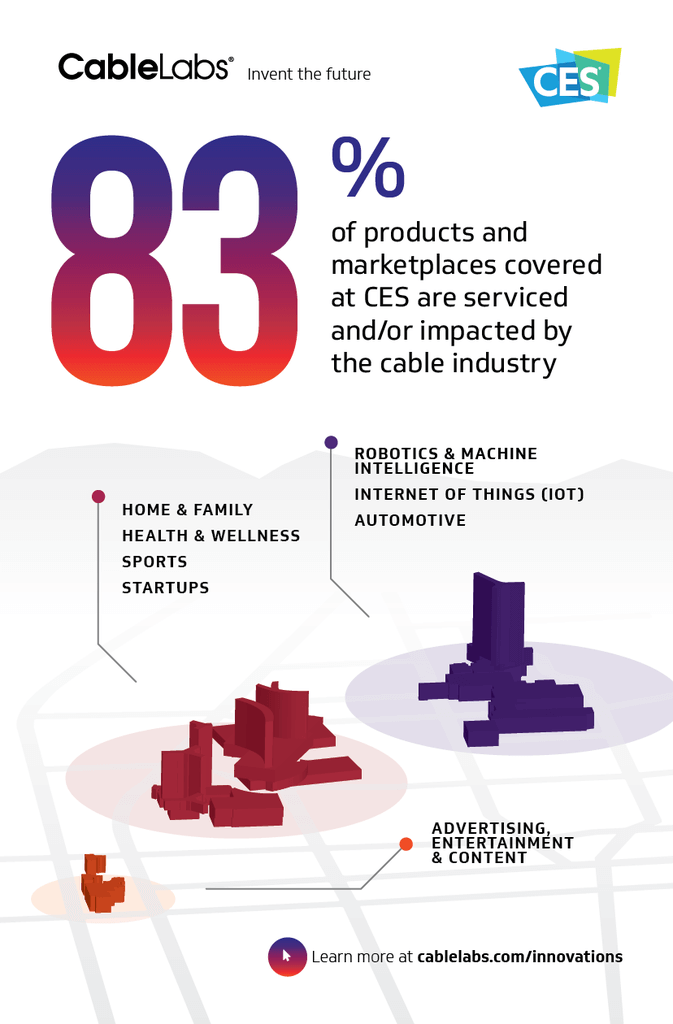
Follow us on twitter to catch up on the latest news and highlights from CES 2018.
--
Want to know more about the technology trends of 2018? Watch CableLabs President and CEO Phil McKinney’s “2018 Tech Innovation Predictions.”
Consumer
Insights from the 50th Consumer Electronics Show #CES2017
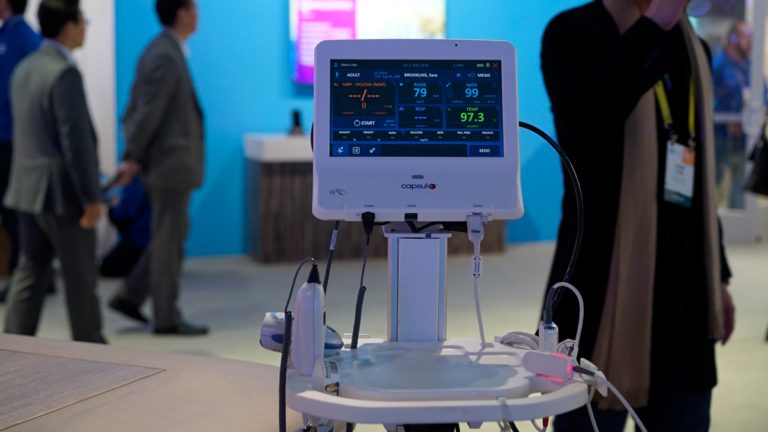
This year’s CES was another record breaking event and was well attended by cable industry representatives. The event staff reports over 177,000 people attended to view nearly 2.5 million square feet of exhibit space. Over the next several weeks, analysts and pundits will contemplate the trends and shifts that are ongoing in the industry. In the meantime, here are some thoughts on a few key areas.
Everything is being connected in dozens of ways. Connected everything is going to drive huge bandwidth consumption while also presenting interesting challenges. Wireless connectivity options abound, from traditional WiFi and Bluetooth to a plethora of ecosystem scale consortia options such as ZigBee, ZWave, Thread, and ULE Alliance. Cellular based connectivity is expanding with companies using lightweight modems to easily connect new products such as health device hubs and pet monitors to cloud services. With so many options, however, providing a consistent and securable home and business environment will remain challenging — no one hub will seamlessly connect all the devices and services that are out there, and no one security appliance will keep consumer networks safe.
There is a huge focus on health and wellness, with several hundred companies exhibiting in the Health & Wellness and Fitness & Technology Marketplaces. These focus areas were well exhibited by the large manufacturers such as Samsung, Sony, Intel, and Qualcomm as well. In discussions with product managers, however, it’s clear that we might not have learned too many lessons about the need to secure medical and fitness devices and services. Many vendors continue to integrate minimal security, relying on unsecured Bluetooth connectivity to a hub that often does not leverage any form of strong identity for authentication. Fortunately, the Open Connectivity Foundation will continue to provide a path for addressing this shortfall, and membership in the Foundation significantly increased this week. Moreover, several vendors are leveraging IoTivity which will provide clean paths to secure implementations for connected environments.
Smart, highly connected homes were also a major theme, again with hundreds of vendors showing completely integrated solutions, hubs, and thousands of end devices. Connected lightbulbs remained a continuous and omnipresent idea, as were security systems. However, it’s clear there is not any winning market strategy here yet. With dozens of vendors offering complete solutions and even more offering different controllers, it seems the market is fragmented! On the other hand, Brian Markwalter of CTA advises they expect to see 63% CAGR for the smart home market in 2017. It seems this is a great opportunity for service providers to pave the way to some convergence and integration simplification for home owners.
It’s hard to go to CES and not leave very optimistic about the future. There is so much good stuff coming that is going to impact all of us. From better screens to more agile and secure health care devices to safer cars to anything else you can imagine. And, there are so many ways to add value to mundane items just by connecting them to a network. Given Metcalfe’s law (“the value of a telecommunications network is proportional to the square of the number of connected users of the system”), the value of the cable network appears to be headed for much higher with the growth of so many connected devices. And, it’s clear that we’re going to need all the bandwidth to the home that DOCSIS can bring! Our challenge is ensuring easy and flexible use through good strategies and standards for interoperability and security.
Consumer
2017 Innovation Predictions
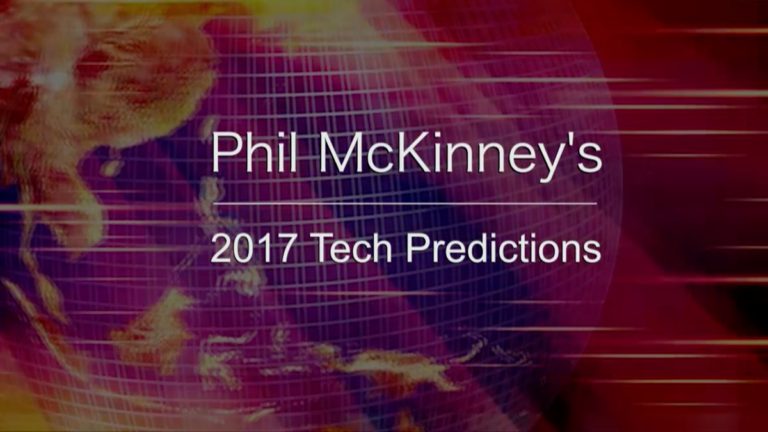
It’s that time of year for me to give my innovation predictions.
My top three predictions for 2017 are:
- Mixed Reality
- IoT Security
- Flexible Displays
Please take a look at the video where I elaborate on these three predictions.
Best wishes for a great year.
-----Video Transcript
It's that time of year for me to give the predictions of the top three innovations coming in 2017. Now, I've been doing these predictions for many many years and actually have a pretty good track record. I've made most, I've missed a few. But also, I like to go out on a limb and give some predictions that kind of, maybe, push the envelope a little bit.
What's the number one prediction for 2017? It's around augmented reality, virtual reality, but more importantly, mixed reality. Mixed reality is really this combination of AR and VR where you actually see data and information that you can act upon. This kind of an experience is going to be really mind-blowing for people. It's really a great opportunity for content creators to think differently about the content they produce but also about the storytelling, the way of telling stories, and the way of making information interesting and actionable. So stay tuned, this is going to be a very exciting area. The first part of the year we're going to see more work in the hardware technologies. As we get into the latter half of the year, it's really going to be exciting to see some of this new content that is going to become available.
What's the second prediction? Second prediction is IoT: the Internet of Things is going to continue to be the hot area for 2017. Now, we've seen this introduction of IoT devices really explode in 2016. But one of the concerns that's really come out is security. The ability for hackers or people who are not friendly to be able to access IoT devices in consumers' homes has really become front-page news. So the question I have is, the technology is there, it's going to continue to expand, it's continued to be interesting. But as an industry, the security area has to be addressed before I predict broad consumer adoption of IoT devices. We're going to see IoT in everything from home security, home monitoring, heating, air conditioning, home appliances. We're also going to see some IoT devices and interesting areas like home health: healthcare devices that allow your doctors to monitor your healthcare, maybe after procedures or whatever, in your home and that just reinforces this one critical area which is around security to make this technology broadly available.
The third area is around display devices. Now, if you go back and you look at my predictions in previous years, I've talked about 3D the year it became a hot issue at some of the trade shows. We've talked about 4K. 4K high dynamic range (HDR) which is broadly going to be just a boon area for this year. In fact in 2016, in going into the holiday season, it became really very prevalent for people to buy these new kinds of TVs. What is left to be done in display technologies? What's left to be done is around flexible displays. Flexible displays being built on new kinds of materials such as this mylar, which is the backing material that's being used in some of the flexible displays that you'll see come available in the first part of 2017. This allows for displays to be manufactured that are one millimeter thick that literally you can attach to your wall as if it were wallpaper. What does this mean for the broad marketplace? When you have that kind of technology -- very low-cost but very flexible -- from the standpoint of how it gets used, we will see flexible displays on TVs as obvious, but also transforming things like whiteboards, collaboration technologies, technologies used in the classroom, advertising displays in retail and billboards. You'll be able to get these kinds of displays at such a low cost that you can literally transform every flat surface you see and turn that into a new kind of display for use of all kinds of ways.
So those are the three predictions for 2017. We have everything from the AR/VR/mixed reality, the Internet of Things, and these new kinds of displays.
Thank you!
Consumer
Multiple Access Point Architectures and Wi-Fi Whole Home Coverage
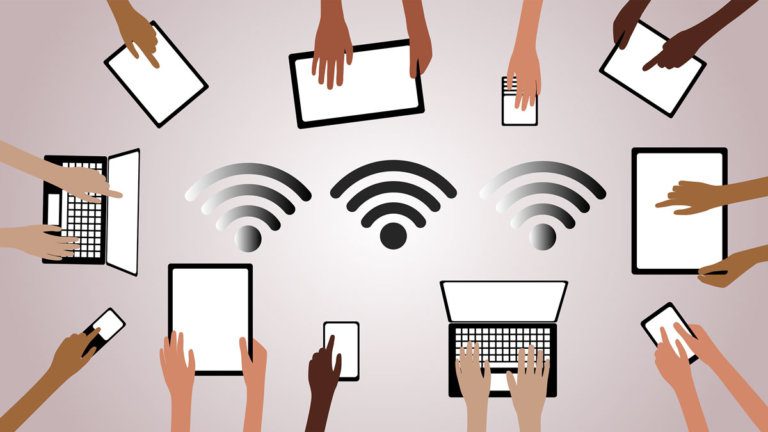

As mentioned in a previous blog post on AP Coordination by my colleague Neeharika Allanki, homes sizes are growing and the number of client devices in a home network are increasing exponentially. There is a need for not only consistent performance in terms of throughput and connectivity, but also Wi-Fi coverage throughout the home. Consumers often need more than one Wi-Fi Access Point (AP) in the home network to provide that coverage.
Many houses in the world do not have existing wires that can be used to network these APs together, and so one of the easiest and most cost effective ways to provide whole home Wi-Fi coverage is by using Wi-Fi itself to connect together the APs in the home. The technologies available today that can do this are Mesh APs (MAPs), Repeaters or Extenders.
Wireless repeaters and extenders have been around for years due to consumers seeing the need to expand Wi-Fi coverage in their homes. While some form of wireless mesh networking has been around for more than ten years, until recently there were not products designed for the home that used mesh to connect multiple APs. In the past year, there has been a dizzying array of product announcements and introductions for home Wi-Fi coverage, with many of them using mesh networking.
Mesh Access points (MAPs) are quickly gaining traction in home networks mainly due to ease of installation (even over Repeaters/Extenders) and the promise of high throughput with whole home coverage. A mesh AP network can be defined as a self-healing, self-forming, and self-optimizing network of MAPs. Each MAP can communicate with others using smart routing protocols and thereby choose an optimal path in order to relay the data from one point to another.
As mentioned before in our AP Coordination blog, client steering (moving Wi-Fi clients to the best AP in each location) and band steering (moving and keeping Wi-Fi clients on the best band: 2.4 GHz or 5 GHz) are very important in any multi-AP solution, such as mesh or an AP + repeaters/extenders network. This is needed to ensure that each mobile client stays connected to the best AP for its current location. Without client steering, Wi-Fi clients may show connectivity to Wi-Fi, but throughput may suffer tremendously. This often shows up as the dreaded “Buffering…” message when streaming a video or a slow progress bar when loading a web page. In a fully wireless multiple AP solution, client steering and band steering is even more critical due to the throughput and latency penalty when traffic is repeated over Wi-Fi from one AP to another. As MAPs communicate with each other to form the mesh network, they implement some form of AP Coordination, and it is usually proprietary in nature.
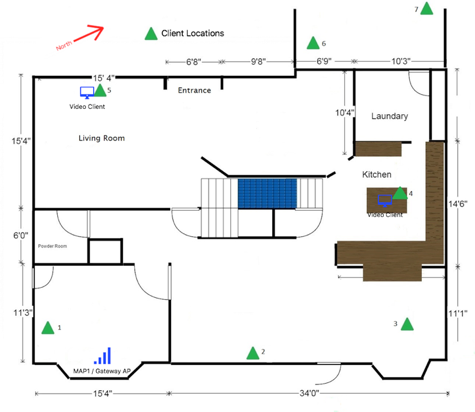
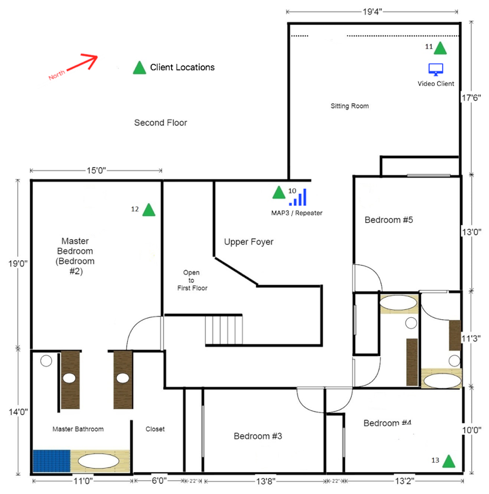
CableLabs recently tested mesh networking solutions and AP + repeater solutions consisting of 3 APs in a 5000+ sq. ft. test house. We performed throughput, jitter, latency and coverage testing at more than twenty locations in and around the house. We found that we were able to run two streaming videos, at HD bitrates (~20Mbps), to video clients in the home while also delivering over 50Mbps to our test client. Both mesh and AP + repeater solutions were able to handle this video throughput, as well as deliver over 50Mbps throughput throughout the house and even to some areas 20’ outside the house. This is excellent news for consumers whose access to the Internet is wireless and who want that access everywhere in their homes.
Next Steps
CableLabs is working with vendors to define a standardized AP Coordination Protocol that would allow all APs in a home network to share information to allow them to make client steering decisions, along with other network maintenance tasks.
Consumer
A Look into the Near Future
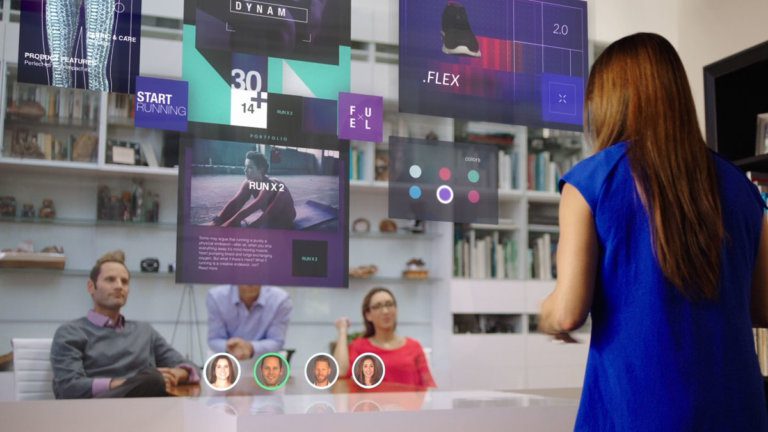
CableLabs has done something surprising for an Innovation and R&D Lab. They have released a short film that provides a vision of possibilities arising from the high speed low latency networks that will connect our homes, businesses and mobile devices in the not too far distant future.
Portraying a number of vignettes in the life of a family, the video illustrates the impact of new technologies on a range of human interactions. These include holographic based education, autonomous vehicles, augmented and virtual reality gaming, collaborative work and much more.
The film, produced from the vision of the CableLabs innovation team, offers a compelling view into the technology driven transformative shifts that could occur over the next five years.
Filming was not a trivial task. To properly illustrate each technology, special effects were required in most of the shots. The visual FX company, FirstPerson, was brought on to the team to 3D map each set in preparation for post production. After shooting was completed, the FX team was tasked with matching the 3D generated maps to the real locations, bringing the virtual reality technology to life.
To see the film and more, go to www.thenearfuture.network
Consumer
Industry Set-Top Box Voluntary Agreement Initiative Wins Environmental Leader Top Project of the Year Award

Last week, at the 2016 Environmental Leader Conference, the Set-Top Box Voluntary Agreement (STB VA) received special recognition to reduce energy consumption related to set-top boxes in consumers’ homes. The Environmental Leader Top Project of the Year Award is a program recognizing excellence in projects that provide companies and consumers with environmental, sustainability and energy management benefits. The winners are selected by a panel of distinguished judges with experience in environmental management, headed by an unbiased judging coordinator from an outside Environmental Leader.
This is a team win for all the participants in the Voluntary Agreement: service providers - AT&T, Cablevision, CenturyLink, Charter (including Time Warner Cable and Bright House Networks), Comcast, Cox, DirecTV, DISH, Verizon; manufacturers – Arris, Echostar Technologies, and Technicolor; energy conservation advocates – ACEEE, ASAP, and NRDC; and supporting organizations – CableLabs, CTA, and NCTA.
Established in 2012 and expanded in 2013, the STB Voluntary Agreement (VA) includes many commitments. First and foremost, each service provider commits to ensuring that at least 90% of their STBs purchased each year will consume less energy than the allowances set forth in the VA. The VA enlists an Independent Administrator to evaluate annual reports from each signatory to ensure compliance, and aggregates the information into a public annual report. Every year, an independent auditor tests STBs in nearly 100 homes across the United States to verify the service providers’ reported values. And, for consumers, each service provider must publicly report the energy usage of each STB model purchased since the beginning of 2014. In addition, service providers are deploying whole-home DVR solutions and upgrading software on fielded models to enable light sleep to further reduce the energy usage.
CableLabs is proud to be a part of this historic initiative and to support all the signatories in the agreement. CableLabs runs technical working groups to update the VA with new features and energy allowances, and works with specification teams and manufacturers to identify new ways to reduce energy consumption. The CableLabs Energy Lab supports testing and reporting of STB energy consumption, and CableLabs hosts the required public information for all of the cable signatories. CableLabs also works on advanced home networking solutions to reduce the complexity and number of STBs required in a home.
The STB VA has already saved consumers over a billion dollars in energy costs and avoided over 6 million metric tons of CO2 emissions. We are honored to receive this prestigious award and will continue to strive to make a difference in this industry.
Receiving the awards at the Environmental Leader 2016 conference are, from left to right: Doug Johnson (CTA), Gary Langille (DISH/Echostar Technologies), Paul Nastu (Environmental Leader), Debbie Fitzgerald (CableLabs), and Steve Mace (NCTA)
Consumer
AP Coordination in Home Networks
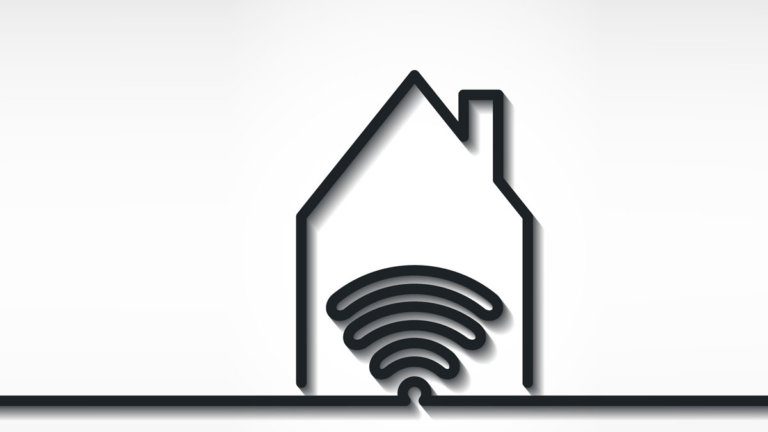

Multiple Access Points Can Improve Home Wi-Fi Coverage: The Secret Sauce is AP Coordination
Before we address AP Co-ordination in Home Networks, it is important to note that average home sizes have been increasing at a steady pace in the past four decades as seen from the figure below.
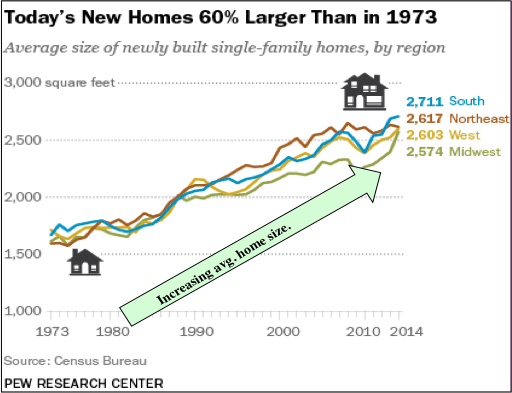
Increasing Home Size
As consumers, we expect our home Wi-Fi network to be ubiquitous, providing reliable connection speeds wherever we are in the home. A single AP may not be capable of providing whole home coverage, especially in larger sized homes. In a recent blog post, my colleague Vikas Sarawat described how a range of multi-access point architectures have emerged to solve this coverage gap. These architectures solve the whole home coverage problems but there are other gaps that need to be addressed in order to have an overall positive Wi-Fi experience.
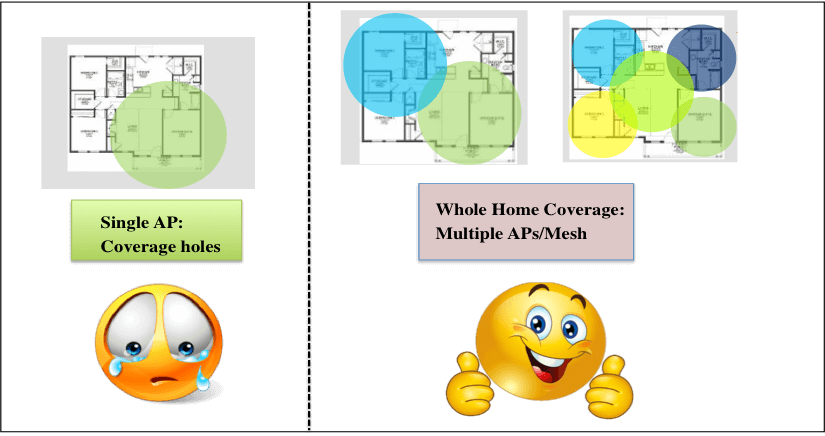
Single AP vs. Multiple AP Architecture
For example, most consumer grade access point solutions currently lack a centralized Wireless LAN controller (WLC). In general, a WLC acts as a commander-in-chief which manages and controls all the APs that it serves and thereby leads to network optimization.
In the absence of a centralized WLC, multiple APs do not communicate with each other. In fact, they can at times treat each other as rogue APs that are not even operating on the same network.
Hence, there needs to be some sort of a direct communication protocol between these multiple APs in-order to provide a good Wi-Fi experience to the consumers. Although AP co-ordination has been a topic of research in a controller-based architecture ecosystem (e.g., for enterprise and community Wi-Fi environments) for some years, historically, the residential consumer premise equipment vendors have not paid much attention to coordination since most homes only had a single AP. To address this shortcoming, CableLabs is actively working on defining and standardizing the AP coordination protocols.
Our goal is to have a lightweight AP co-ordination solution that provides the following two benefits:
Optimal AP selection: When there are multiple APs available, many clients rely solely on signal strength to decide which AP to connect to, but it might not always be optimal concerning throughput for the client.
There are often conditions where a lower received signal strength indicator (RSSI) from the gateway AP may provide better throughput than a stronger RSSI from the repeater. The client cannot determine which is the best connection on its own – the infrastructure must inform it. Choosing the best point of attachment in each location is a decision that warrants information and intelligence on the client-side, the network-side, or possibly both.
Client Steering: APs also need to decide when and how to steer clients to the best AP based on network conditions (e.g., load, bands). This is especially important since many clients prefer to stay associated with one Wi-Fi network even though another Wi-Fi network with “better” connectivity is available. This is commonly referred to as the "sticky client" issue.
With AP co-ordination, the APs can exchange information on how best to get rid of the sticky client problem in a standard fashion. A partial solution has been defined in the IEEE 802.11k and 802.11v standard but not many APs or clients implement them yet.
While the IEEE 802.11k defines methods of retrieving information from clients in the form of neighbor requests and reports, the IEEE 802.11v standard provides the AP with the ability to configure client stations wirelessly in the form of the BSS Transition Management (BTM) feature.
To summarize, AP coordination is an important topic of research, particularly within the home networks where there is no WLC. CableLabs is actively engaging with the vendor community to develop a standard way of implementing in-home AP coordination protocols which we plan on submitting to the standards bodies such as WFA and WBA in the near future.
Consumer
Solutions for Whole Home Wi-Fi Coverage
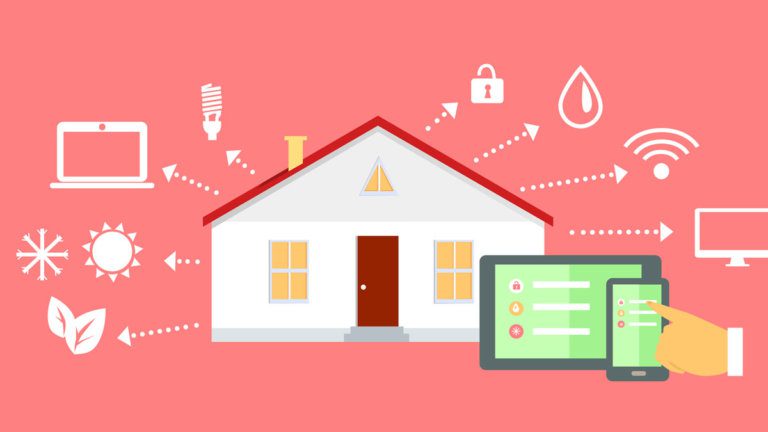
For the majority of homeowners, a single Wi-Fi Access Point (AP) is enough to provide whole home coverage with reliable performance. However, there are homes where a single AP provides insufficient coverage or has unreliable performance in certain areas of the home. For example, as the size of the house increases (> 3000 square feet), the number of locations in the house with poor signal strength (RSSI at -80 dBm or lower) increases. Since Wi-Fi supports adaptive modulation, the performance and quality of the link between the AP and client decreases as the path loss between the AP and client increases.
Wi-Fi performance can be affected by a number of factors, including the construction material of the home, and interference from other Wi-Fi networks using either the same, adjacent, or alternate channels. Similarly, non-Wi-Fi sources such as 5 GHz cordless phones, baby monitors and microwaves can have an impact on the performance as well. Furthermore, location of the AP in the customer’s home can make a big difference in the Wi-Fi signal coverage and performance. Comcast has an excellent blog, “10 Ways You Might Be Killing Your Home Wi-Fi Signal” that provide guidelines on where not to place your Wi-Fi AP.
Even with the optimal placement of the AP, if there are locations in the home with no or poor Wi-Fi signal, we recommend the use of multiple APs.
For a multiple-AP solution, consumers have a number of options. Ultimately, it comes down to how the multiple APs in the home are connected to each other. These options can be subdivided into two solutions, wireless-only and hybrid:
- Wireless-only solutions make use of the wireless link to connect the APs to each other. This includes products such as repeaters, extenders, and mesh networks.
- Hybrid solutions make use of wires to connect the multiple APs. Examples products include MoCA-to-Wi-Fi, Powerline-to-Wi-Fi, and Ethernet-to-Wi-Fi extender.
In our previous blog, we presented field test results to show the difference between wireless-only architectures through the use of Wi-Fi Repeater and Extenders. In this blog, we will address Hybrid solutions using commonly available in-home coaxial cables and compare their performance with wireless-only solutions. While a consumer has many variables to consider before choosing a solution (e.g., complexity, availability of wiring, cost), this article will focus on comparing data rate with respect to SNR.
Performance Comparison of Hybrid versus Wireless-only Solutions
For the analysis, we used the Wi-Fi network configuration described in Table 1.
Table 1: Network Configuration used for Analysis
| Name | Description |
| Wi-Fi Client: | One client with 2x2:2 MIMO and 802.11ac |
| Wi-Fi Channel Bandwidth: | 80 MHz channel for both fronthaul and backhaul |
| AP, Repeater and Extender: | 4x4:4 MIMO, 802.11ac |
| Link between AP and Wi-Fi Repeater: | Modulation Coding Scheme (MCS) 3 with 4 Spatial Streams |
| Link between AP and Wi-Fi Extender: | MCS 3 with 4 Spatial Streams |
| Link between AP and MoCA to Wi-Fi extender: | MoCA2.0 (bonded) |
| Airtime fairness: | Repeater supports airtime fairness for the link between the AP/repeater and the AP/client |
These are example configurations and were selected to demonstrate the difference between solutions. It is important to note that for all configurations (Wi-Fi repeater, Wi-Fi Extender and MoCA to Wi-Fi Extender) analyzed in this article, the fronthaul link between the AP and client, and extender and client is the same (i.e., 4x4 extender/repeater and 2x2 client).
In the following graph (Figure 1), we provide a theoretical comparison of data rate versus Signal to Noise Ratio (SNR) for the hybrid and wireless-only solutions. While the X-axis shows the SNR (measured at the client) for the AP, extender, and repeater, the Y-axis shows the Data Rate. The SNR first deteriorates as the client moves away from the AP (blue star) and then improves as the client moves closer to the extender (red star). Finally the SNR deteriorates again as the client moves away from the extender (red star). For our analysis we assume an interference free environment.
In this analysis, we also assumed that each extender is placed in the same location (highlighted with a red star on the chart) with respect the AP. The location of the main AP is reflected with a blue star on the chart.
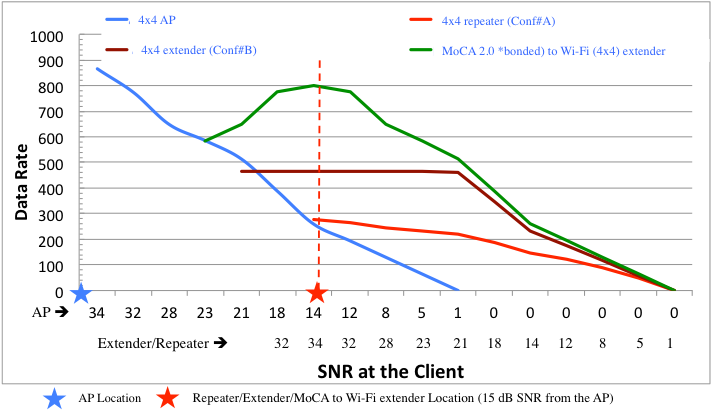
Figure 1. Hybrid and Wireless-only Solution Comparison
The blue line shows the data rate with respect to SNR that the client can achieve while it is connected to the AP. Similarly, the red, brown and green lines show the data rate with respect to SNR that the client can achieve while it is connected to the Wi-Fi repeater, Wi-Fi extender and MoCA to Wi-Fi extender respectively. In our analysis we assumed that the client and network are intelligent and can steer the client from the AP to Wi-Fi repeater, Wi-Fi Extender and MoCA to Wi-Fi Extender at the points where red, brown and green lines intersects with the blue line.
As shown in Table-1, the same repeater/extender and client configurations were used for both the wireless-only and hybrid solutions; specifically, 4X4 Repeater/Extender and 2X2 client with 80 MHz channel. Therefore, as expected, the range improvement (i.e., the increase in coverage area) is about the same for both wireless-only and hybrid solutions. This is illustrated in Figure-1, where the red, brown, and green lines eventually converge as the client moves away from the AP.
The difference in data rate performance is primarily due to the difference in the performance of the backhaul link between the AP and the extender. In Figure 1, we observe that the wired backhaul link outperforms the wireless backhaul link due to the higher backhaul data rate that can be achieved by a MoCA 2.0 bonded channel relative to a 5.8 GHz Wi-Fi backhaul in that location. Given the location of the Wi-Fi Extender with respect to the AP, the wireless backhaul link supports a maximum data rate of ~518 Mbps while the MoCA2.0 (bonded) link can support data rates as high as 800 Mbps.
As we see in Figure 1, the contour for MoCA 2.0 (bonded) to Wi-Fi extender looks different than the lines for other systems. The reason is that the performance of the MoCA 2.0 (bonded) to Wi-Fi extender is limited by the capacity of the fronthaul link between the extender and client. On the other hand, the performance of Wi-Fi Repeater and Extender, when the client is in close range, is limited by the capacity of the backhaul link between the AP and Repeater and AP and Extender.
Figure 2 shows the details of Wi-Fi Repeater (Conf#A) and Extender (Conf#B) configurations that we used for our analysis.
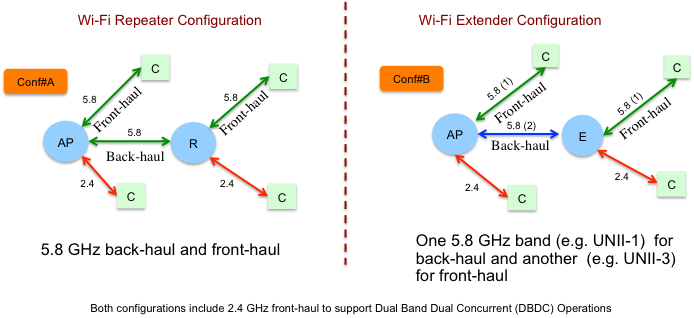
Figure 2: Wi-Fi Repeater and Extender Configuration used for Analysis
What did we learn?
Although wireless-only solutions are highly convenient, the hybrid wireless solutions using MoCA2.0 (bonded) or 1000Base-T for backhaul offer much better data rate performance. In the absence of structured wiring in the home, wireless-only networks (i.e. using Wi-Fi repeaters or extenders) can be an efficient and convenient near-term solution to extend coverage and enhance data rate performance.
-- Authored by Vikas Sarawat
Consumer
Hello Blockchain . . . Goodbye Lawyers?


As the blockchain technology star begins to eclipse Bitcoin and the other cryptocurrencies that rely upon it, there has been an increase in research and development into using blockchain for “smart contracts.” Smart contracts are computer programs that facilitate, verify, execute, and enforce a contract. While smart contracts have existed to a limited extent for years in the commodities markets, vending machine, or adjustable rate mortgage industries, blockchain technology enables smart contracts to expand to cover new uses and, ultimately, become mainstream because contracts in blockchains are attestable, immutable, and visible.
What is a Contract? What is Blockchain?
A contract, in its simplest terms, is an agreement between people to do or refrain from doing something in exchange for something else. The agreement, generally, can be formed through a mutually signed document, a series of emails, verbal communication, clicking “I Agree” or any action showing agreement. A contract may be formed by the simple nodding of the head. A “person” can be a human being or an entity created in law with the ability to contract, like a corporation or a limited liability company. In order for an agreement to be upheld legally, the agreement cannot be against the law. Yet another reason why you don’t see drug dealers in court -- criminal court excepted.
Blockchain is a cryptographic technology that is used to create distributed, verifiable electronic ledgers to record events. For more elaboration refer to Steve Goeringer’s post. Smart contracts leverage blockchain technology to not only record the individuals and the amounts in the transaction but can also set up a self-executing “if this than that” structure using scripts.
A Smart Contract in Action
For example, if you and I were to agree upon a price for you to buy my car, we would both be worried about certain risks. I would be afraid whether or not your check will clear. You would be concerned if I actually hold a clear title to the car, whether the car is mechanically sound, if there are any liens on the car, and would want to confirm the odometer reading is accurately stated on the title. Addressing these concerns may take a week or more. With a blockchain, all the concerns are addressed simultaneously.
For this example, let’s assume we are living in the near future and the title (VIN number, ownership and odometer reading – the latter due to my car phoning in to update its secured record), and any liens are encoded on the blockchain, the payment will be in Bitcoin (or some other cryptocurrency), and my contract with the mechanic can also be on the blockchain. I would load the coded representation of our agreement onto the blockchain. The blockchain would immediately determine if you had the funds, I had the proper title, check for the “this car is okay” approval from the mechanic, check (and pay off) any liens and then, if all the conditions are present, transfer your payment to me, and transfer and record the title on the blockchain. We receive the mutual “okay” on our smart phones and I give you the car key. The sale of the car becomes spontaneous. So long as the cryptography is sound, there is no longer the need for trust. That is, I would not have to trust you to have the funds to purchase the car and you would not have to trust that I actually had title to the car, the car was mechanically sound, there were no liens on the car, and the odometer reading is correct.
Smart Contracts in the Cable Industry
Smart contracts can remove friction and provide transparency in the cable supply chain. For example, smart contracts could ensure that every time a cable operator shows a movie, appropriate payments are instantaneously made all the way down the programming supply chain. There is no need for audit as the transaction history is readily secured and apparent in the blockchain. Smart contracts could also reduce costs by streamlining content purchasing based upon industry standards. Smart contracts could also be readily applied to advertising insertion with payment made in real time.
So We Don’t Need Lawyers Anymore?
For certain simple transactions, for which you probably wouldn’t hire a lawyer, you still wouldn’t need a lawyer. However, the use of blockchain may reduce the need for a using a lawyer to resolve post-contract issues like lack of payment or, in the previous example, bad title. Smart contracts may reduce the need for litigators but become an additional tool for the transactional lawyer to master. The question may be better phrased as, “do lawyers need to learn coding along with Latin?” or “do coders need law degrees?” or even, “is coding a new role for paralegals?” Written contracts are legal documents and while you are free to draft your own, drafting for others constitutes practicing law without a license – which is against the law. While smart contracts will undoubtedly impact lawyers and the practice of law, smart contracts will not eliminate the need for lawyers right away. Smart contracts may, however, be one of several technologies that will bring us one step closer to eliminating or reducing the need for lawyers in the future.
Consumer
Li-Fi – A Bright Future for Home Networks

At CableLabs, we are continually researching new methods of in-home wireless network distribution, and one exciting new contender is Li-Fi.
What is Li-Fi?
Li-Fi is the modulation of a free-space beam of light in order to transmit a signal. It can be thought of as analogous to Wi-Fi, just in a much higher frequency band (430 – 770 THz vs. 2.4 GHz). We’ve actually been using this same basic concept for over 100 years, in the form of Morse code being transmitted from ship to ship via signal lamps.
The Shannon–Hartley theorem allows us to calculate the maximum bitrate of a communications channel with a specific bandwidth. Since capacity increases with bandwidth, we can immediately see the vast potential of Li-Fi, which has ~340 THz to work with in the visible light frequencies. Compare that with Wi-Fi, which has less than 1 GHz available and is able to provide over a gigabit per second, and you can see the potential for ultra-high speed in-home networks. As virtual and augmented reality achieve widespread adoption, these ultra-high speeds will become mandatory.
To give you an idea of just how large a difference this increase in bandwidth is, it’s close to the same difference between the mass of the Earth and the Sun!
Where are we going?
The ideal product is a Li-Fi enabled light bulb in the same form factor that consumers are used to now – and with the same ease of installation. Li-Fi could be a viable solution to improving the coverage and reliability of a home network by reusing existing light fixtures. Just screw the bulb in and you’ve expanded your network.
The other side of the connection is the endpoint device, and a number of consumer device manufacturers are beginning the process of integrating Li-Fi. Apple is exploring adding Li-Fi to their mobile devices, which is a natural product evolution, as the majority of smartphones already contain the two things needed for Li-Fi, a light detector (the camera) and a light emitter (the camera flash).
Where are we today?
CableLabs has fully functioning prototypes of a single-channel Li-Fi system, which have proved to achieve data rates of around 300 Mbps. It is free from Wi-Fi interference and simple to use. Currently the devices need to be directly in-line with each other, so research into improving the signal-to-noise ratio (SNR) is needed for us to achieve omnidirectional Li-Fi.
We’ve also done extensive research into the necessary backhaul systems that will make Li-Fi a useful reality, such as next-generation powerline networking, which uses your existing home electrical wiring as a network. By networking the Li-Fi bulbs together, you can achieve seamless, whole-home coverage. Anywhere there is light, there is connectivity.
The cable industry, with the introduction of DOCSIS 3.1 and beyond, continues to increase Internet connection speeds. These speeds are currently beyond what any current-generation in-home wireless system can handle, so research into technologies like Li-Fi will play a vital part in ensuring customers are able to fully utilize their connection.
Josh Redmore is the Lead Architect in Wireless Network Optimization group at CableLabs.
Follow him on Twitter.


